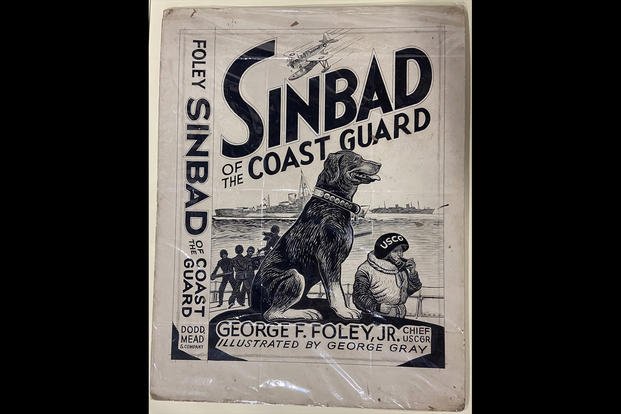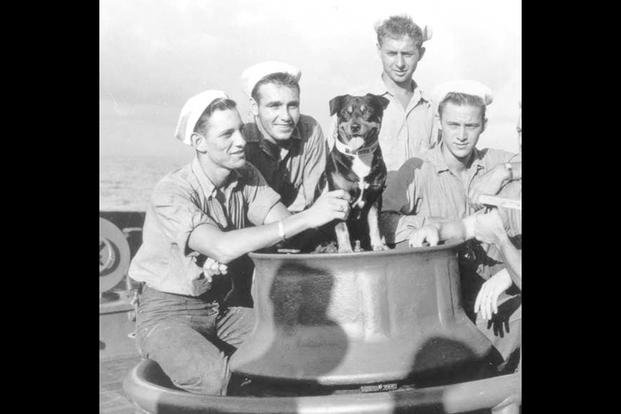In 1937, the crew of the Coast Guard cutter Campbell were out on liberty when they found a mixed-breed dog on the streets of New York, according to the service. Naturally, they smuggled him onto the ship -- and "Sinbad" became one of the most popular U.S. Coast Guardsmen in history.
The mutt's unlikely journey made him the subject of a short movie, a popular book (“Sinbad of the Coast Guard”), and a national publicity tour. After he died, this cherished dog with an affinity for whiskey and beer was deemed worthy of a full military funeral.
Not bad for a Guardsman who tended to sleep on duty, didn't always follow commands and was easily distracted by food.
But what he lacked in capability, Sinbad made up for by simply being what he was -- a beloved companion full of unconditional love, loyalty and endless tail wags.
Named after the fictional mariner, Sinbad was only allowed to stay aboard the Campbell when Capt. James Hirshfield, the ship’s commanding officer, proved no match for terrier mix's affection.
“Let’s hope you enjoy your stay aboard,” Hirshfield told Sinbad.
And enjoy it, Sinbad did. The pup was treated like a distinguished guest, with hammocks and collars made just for him, along with a personal life jacket. Just like any other Coastie, Sinbad’s service and health records were on file with the service. He was assigned service number 069-069. With his life jacket doubling as a mattress, Sinbad’s sleeping quarters moved nightly, depending on which crewmate’s bunk he chose.

As long as the cute pooch was around, the crew’s mood seemed to be brighter. Sinbad, described as “a valiant shipmate, a builder of morale, a sympathetic friend, and a symbol of loyalty and unselfish affection” by a lieutenant commander under whom he served, the dog became just one of the guys.
Except for the fact that he never paid his tab, no one could ask for a better drinking buddy than Sinbad. He was a bar hopper extraordinaire when the crew was on liberty, grabbing a stool at local bars and barking to request a beer. The Campbell’s crew often pooled their money to pay for Sinbad’s cab fare, but sometimes the dog did not make it back to the cutter so easily from a night out. Sinbad’s disappearing acts became so worrisome that the Campbell’s crew developed its own S.O.S. call whenever its dog went AWOL: “Seen Our Sinbad.”
Sinbad became well-known in ports around the world, but not always for the right reasons. He once survived a failed kidnapping attempt in Cuba, and he was the subject of multiple courts-martial, one for chasing sheep in Greenland. The French and British even attempted to buy him on separate occasions, with the latter’s bid of $1,500 worth $33,000 today. Thankfully, that offer was rejected.
Sinbad was blissfully asleep when in February 1943, German submarines attacked the Campbell in an incident that culminated with the warship and a Polish destroyer sinking the U-boat and the Campbell’s engine room being flooded, endangering the cutter’s survival. The Campbell remained disabled for four days in the North Atlantic before being towed to Newfoundland.
What was Sinbad doing during this battle? For the most part, sleeping. Still, that did not stop him from receiving a promotion to Chief Dog -- if only he had not overslept for the promotion ceremony. For that infraction, Sinbad remained at the rank of dog first class.
After Germany surrendered, the Campbell finished its war service as an amphibious warship in the Pacific. Sinbad earned five war ribbons and four battle stars before embarking on a postwar life full of adoration. Besides the national tour and a book release, a newsreel called “A Dog of the Seven Seas” was produced.
Sinbad retired from the Coast Guard in 1948 with the rank of Chief Dog and settled into a comfortable life at the Barnegat Lighthouse in New Jersey. He died on Dec. 30, 1951, at the age of 13.
A Coast Guard magazine editor once said of Sinbad that he “was a salty sailor, but he’s not a good sailor. … He’s been on report several times, and he’s raised hell in a number of ports. On a few occasions, he has embarrassed the United States government by creating disturbances in foreign zones. Perhaps that’s why Coast Guardsmen love Sinbad; he’s as bad as the worst and as good as the best of us.”
When a new Campbell was commissioned in 1988, members of the old crew gifted the cutter with a statue of the famous dog -- one of the few animal mascots in U.S. military history to be classified as a noncommissioned officer.
Want to Know More About the Military?
Be sure to get the latest news about the U.S. military, as well as critical info about how to join and all the benefits of service. Subscribe to Military.com and receive customized updates delivered straight to your inbox.















